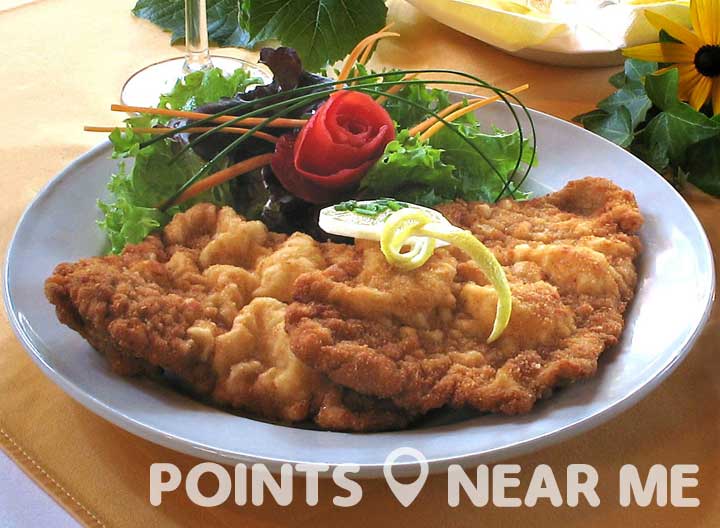Winerschnitzel Near Me
Are you having a hankering for authentic Austrian cuisine to take you right back to the homeland? Few dishes offer the comfort and nostalgia of winerschnitzel. This thin breaded pan fried veal cutlet is a favorite amongst those from Austrian, German, and Swiss descent, making it a true cultural powerhouse.
Are you interested in finding winerschnitzel near you? You’ve come to the right place! Simply browse winerschnitzel near me on the map below and find a list of restaurants, fast food chains, and stands selling winerschnitzel in close proximity to your current location. Need a bit more information on this beloved food? Read on for interesting facts, trivia, and more!
Winerschnitzel Near Me – Find it on the Map
Winerschnitzel Near Me – Winerschnitzel Trivia
What is Winerschnitzel?
If you’re searching winerschnitzel near me, then odds are you’re interested in learning exactly what it is you’ll be chowing down on once you arrive at your destination. Winerschnitzel in its simplest form is a thin crumbed slice of veal. The veal itself usually weighs between 3 and 6 ounces. It is fried in a thin layer of oil, often times in a cast iron pan. When the dish is finished cooking, it is traditionally served up with lemon and often times lingonberry jam and Erdapfel potato salad, pomme rits, or boiled potatoes seasoned with parsley and butter. To give the winderschnitzel a golden brown color, gold dust was at one point added into the crumb mixture. This was meant to make the dish seem more appealing to those who may have been on the fence. Where exactly does the word winerschnitzel come from? According to word etymologies, it basically means schnitzel in the style of Vienna (Wiener) Austria. Given just how uncomplicated the dish itself is, it only makes sense that the name was taken on in a very practical manner. In Austria, the term Wiener Schnitzel is actually protected by law. Any schnitzel that is to be called by that name must meet quality standards and must be made from veal. Apparently some have tried to get away with making schnitzel from other forms of meat, a big no-no, in Austria and Germany.

Proper winerzchnizel is cooked to a crisp on the outside and is tender on the inside.
True or false: The origin of winerschnitzel is not really German or Austrian.
Given that these countries count winerschnitzel as an authentic food steeped in tradition, it can be easy to assume that this dish first found its footing in either Germany or Austria. Unfortunately, that’s simply not true. The origin of winerschnitzel is not really German or Austrian. Consider these facts as you search winerschnitzel near me. According to food historians, the idea of tenderizing a piece of tough meat by pounding is as old and ancient as the history of man himself. Even the Romans left behind evidence of the refinement of a thin slice of meat that was dredged, breaded and fried all the way back in 1 Century BC by Apicus. This was the first guy to have ever written a cookbook. In the middle ages, it was shown to have been a very popular dish in Northern Italy and what is considered Austria in the current day. This is where veal was most common during that particular point in history.
Winerschnitzel Near Me – Winerschnitzel Facts
The Key to Good Schnitzel
Believe it when we say that searching winerschnitzel near me won’t always produce five star restaurants, but there is one way to ensure that you’re always getting the best winerschnitzel and that’s to understand how winerschnitzel is best prepared. According to schnitzel experts (yes they do exist), the key to good winerschnitzel is timing. The veal must be pounded very thin, typically a quarter of an inch or less, and then is to be dipped first in flour, then in egg that has been beaten with a little water or milk. It should then be dipped in breadcrumbs that are ideally made with fine sieved crumbled Vienna bread. Other types of bread will do, but Vienna bread is known to produce the best winerschnitzel. Excess flour and crumbs are considered to be ruinous of an otherwise good recipe. This is why almost every recipe rules out coating and refrigerating the meat overnight or in advance. It must all be done at one time or the winerschnitzel can be compromised. Once the veal is coated and ready, it’s a true race against the clock. The veal is placed in the pan and only turned once. It is finished within 5 to 10 minutes depending upon the actual thickness of the cutlet. When it comes to frying up the schnitzel, lard is generally recommended as the best frying fat, though some chefs prefer oil. No matter what fat is ultimately used, Viennese cooks all agree that the objective is meat that is moist and tender and an outside coating that is crisp and flavorful. The schnitzel should never seem greasy in flavor or in texture. One chef wrote that the best test is to sit on a piece of schnitzel. If your pants don’t have a stain from excess oil, you’re in the clear. If they do, you have stained paints and bad schnitzel.
Finding Schnitzel
If you’re searching winerschnitzel near me, you’ll have no problem in finding winerschnitzel on the menu of almost any Austrian or German restaurant that seeks to offer traditional fare. From an elegant dining room to a casual tavern or beisel, winerschnitzel can almost always be found on the menu. Of course, an authentic restaurant will boast Viennese chefs that know the proper steps to be taken in preparation and the dishes that best accompany a good winerschnitzel. Do your research, read reviews, and prepare for a dish that might just rock your world.












